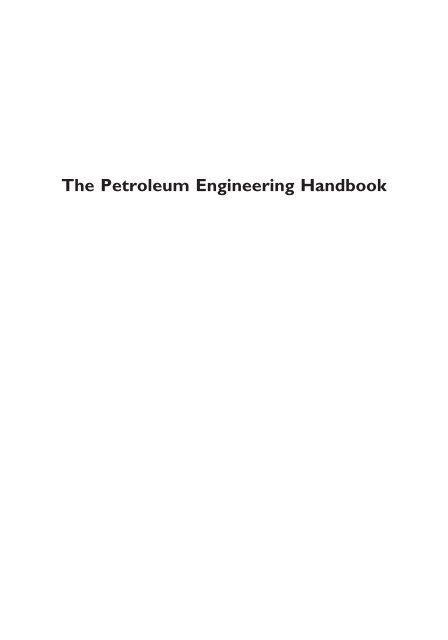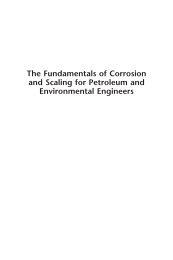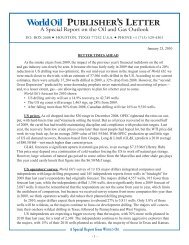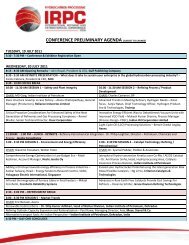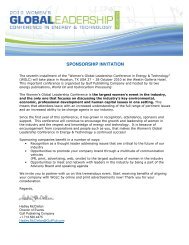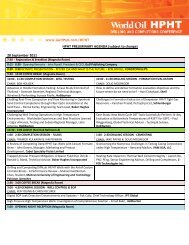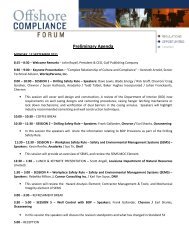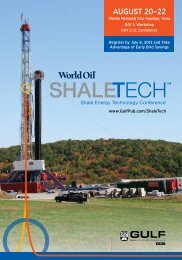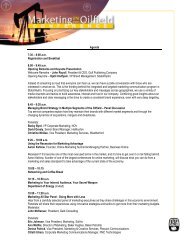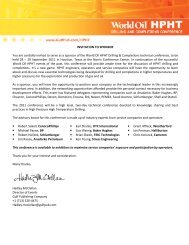The Petroleum Engineering Handbook - Gulf Publishing Company
The Petroleum Engineering Handbook - Gulf Publishing Company
The Petroleum Engineering Handbook - Gulf Publishing Company
You also want an ePaper? Increase the reach of your titles
YUMPU automatically turns print PDFs into web optimized ePapers that Google loves.
<strong>The</strong> <strong>Petroleum</strong> <strong>Engineering</strong> <strong>Handbook</strong>
<strong>The</strong> <strong>Petroleum</strong> <strong>Engineering</strong> <strong>Handbook</strong><br />
Sustainable Operations
<strong>The</strong> <strong>Petroleum</strong> <strong>Engineering</strong> <strong>Handbook</strong>: Sustainable Operations<br />
Copyright © 2007 by <strong>Gulf</strong> <strong>Publishing</strong> <strong>Company</strong>, Houston, Texas. All rights reserved.<br />
No part of this publication may be reproduced or transmitted in any form without the prior written<br />
permission of the publisher.<br />
<strong>Gulf</strong> <strong>Publishing</strong> <strong>Company</strong><br />
2 Greenway Plaza, Suite 1020<br />
Houston, TX 77046<br />
10 9 8 7 6 5 4 3 2 1<br />
Library of Congress Cataloging-in-Publication Data<br />
Khan, M. Ibrahim, 1968–<br />
<strong>The</strong> petroleum engineering handbook : sustainable operations / M. Ibrahim Khan and M. R. Islam.<br />
p. cm.<br />
Includes bibliographical references and index.<br />
ISBN 978-1-933762-12-8 (alk. paper)<br />
1. <strong>Petroleum</strong> engineering–<strong>Handbook</strong>s, manuals, etc. I. Islam, M. R. (M. Rafiq), 1959– II. Title.<br />
TN870.K475 2007<br />
665.5–dc22<br />
2007020540<br />
Printed in the United States of America<br />
Printed on acid-free paper. ∞
Contents<br />
Foreword<br />
Preface<br />
Acknowledgements<br />
Nomendature<br />
ix<br />
xi<br />
xv<br />
xvii<br />
CHAPTER 1 Introduction 1<br />
CHAPTER 2 <strong>The</strong> New Management Guidelines 5<br />
2.1 Introduction 5<br />
2.2 Current Practices of <strong>Petroleum</strong> Operations 6<br />
2.3 Problems of Current Operations 9<br />
2.4 Sustainability in <strong>Petroleum</strong> Operations 14<br />
2.5 Tools Needed for Sustainable <strong>Petroleum</strong> Operations 19<br />
2.6 How the Green Supply Chain Model Leads to Sustainability 31<br />
2.7 Benefits of the New Model 35<br />
CHAPTER 3 Exploration Operations 39<br />
3.1 Introduction 39<br />
3.2 Current Practices of Exploration Operations 40<br />
3.3 Exploration Techniques 46<br />
3.4 Problems with Current Exploration Techniques 56<br />
3.5 Sustainability of Current Exploration Techniques 62<br />
3.6 Accuracy and Uncertainty of Explorations 70<br />
3.7 Special Measures for Sustainable Exploration Technology 71<br />
CHAPTER 4 Drilling and Production Operations 79<br />
4.1 Introduction 79<br />
4.2 Current Practices of Drilling and Production 80<br />
4.3 Production 83<br />
4.4 Problems with Current Practices 85<br />
4.5 Operations in the Ecologically Sensitive Areas 98<br />
4.6 Emerging Technologies and Future Potential 107<br />
4.7 Sonic While Drilling 123<br />
4.8 Knowledge-based Optimization of a Rotary Drilling System for the<br />
Oil and Gas Industry 126<br />
4.9 Future research in production operations 131<br />
4.10 Benefits of Sustainable Drilling and Productions 133<br />
CHAPTER 5 Sustainable Waste Management 135<br />
5.1 Introduction 135<br />
v
vi Contents<br />
5.2 Drilling and Production Wastes 135<br />
5.3 Waste Estimation 140<br />
5.4 Environmental Fate of <strong>Petroleum</strong> Wastes 147<br />
5.5 Current Practices of Waste Management 156<br />
5.6 Evaluation of Current Waste Management Technologies 161<br />
5.7 Alternative Waste Management 173<br />
5.8 Sustainability of Waste Management 183<br />
CHAPTER 6 Reservoir <strong>Engineering</strong> and Secondary Recovery 189<br />
6.1 Introduction 189<br />
6.2 Well Test Analysis 189<br />
6.3 Current Practice in Well Logging 202<br />
6.4 Current Practices of Core Analysis 208<br />
6.5 Practical Guidelines 226<br />
CHAPTER 7 Enhanced Oil Recovery (EOR) Operations 243<br />
7.1 Introduction 243<br />
7.2 Contributions of Different Disciplines 248<br />
7.3 Different EOR Techniques 249<br />
7.4 Gas Injection 254<br />
7.5 Chemical EOR 257<br />
7.6 Microbial EOR 258<br />
7.7 EOR in Marginal Reservoirs 263<br />
7.8 Scaling of EOR Schemes 264<br />
7.9 Environmental Consideration in EOR Operations 268<br />
7.10 Alternative Technologies for EOR 272<br />
7.11 CO 2 EOR Technology 280<br />
7.12 Electromagnetic Heating for EOR 286<br />
CHAPTER 8 Transportation, Processing, and Refining Operations 295<br />
8.1 Introduction 295<br />
8.2 Pipelines and Risk Management 296<br />
8.3 Natural Gas Supply and Processing 309<br />
8.4 Oil Refining 338<br />
8.5 Sustainable Oil Refining Model 350<br />
8.6 Corrosion in <strong>Petroleum</strong> Structures 357<br />
8.7 Hydrate Problems and Some Suggestions 361<br />
CHAPTER 9 Decommissioning of Drilling and Production Facilities 365<br />
9.1 Introduction 365<br />
9.2 Historical Analysis 365<br />
9.3 Type of Oil Platforms/Platform Structures 366<br />
9.4 Environmental Issues in Decommissioning 368<br />
9.5 Toxicity and Degradation of Waste Generation 370<br />
9.6 Decommissioning Regulations 376<br />
9.7 Current Practices of Decommissioning 379<br />
9.8 Case Studies 385<br />
9.9 Sustainability of Offshore Platform Decommissioning 387<br />
9.10 Alternative Approaches 389<br />
9.11 Guidelines for Sustainable Management 395<br />
9.12 Ecological and Economic Benefit of Artificial Reefs from Oil Rigs 398
Contents<br />
vii<br />
CHAPTER 10 Summary and Conclusions 401<br />
10.1 Summary 401<br />
10.2 Fundamental Misconceptions in Technology Development 402<br />
10.3 Understanding Nature and Sustainability 404<br />
10.4 Solutions that would Turn an Implosive Process Around 406<br />
10.5 Conclusions and Recommendations 407<br />
References 411<br />
Author Index 453<br />
Subject Index 459
Foreword<br />
Sustainable Operations <strong>Handbook</strong> for <strong>Petroleum</strong> Engineers is a timely book, which not only provides a<br />
summary of various sustainable practices in petroleum engineering operations, but does it in a manner that<br />
raises a greater awareness of environmental sustainability.<br />
It is not the traditional “technical handbook” one relies upon to get technical information for finding solutions<br />
to an “engineering” problem. It is a book that provides a comprehensive coverage of the systems with<br />
a focus on managerial decision-making. In doing so, it shifts the focus from finding “technical solutions”,<br />
to “managerial decisions” leading towards sustainable practices. It provides step-by-step guidelines towards<br />
such practices in Chapter 2.<br />
Subsequent chapters carry forward a similar unifying theme in combining sustainable management decisions<br />
and operational practices to various segments of the petroleum sector including exploration, drilling and<br />
production, reservoir engineering, enhanced oil recovery, transportation and refining and waste management<br />
practices.<br />
Overall, this book examines current practices of an important industrial segment through the lenses of<br />
“environmental sustainability” and provides a valuable resource to those who will have to steer the petroleum<br />
industry from its current practices down the long road towards achieving true sustainability, not only from<br />
an environmental angle but also from an economic one.<br />
Professor Amit Chakma, Ph.D., P.Eng.<br />
Vice President Academic and Provost<br />
University of Waterloo<br />
Canada<br />
ix
Preface<br />
Nature is perfect, both in space and time. To understand this perfection, one must use the science of intangibles.<br />
<strong>The</strong> premise underlying such a concept is that Nature operates and Humanity detects the tangible<br />
effects and formulates a response. However, the response has to take into consideration the role of processes<br />
within Nature that have up to now remained inaccessible to our capabilities of detection or measurement<br />
and hence “intangible” – either because of where we are looking, or because we become fixated on only<br />
certain tangible aspects that can maximize a financial return in the shortest possible time. <strong>The</strong> hubris of the<br />
contemporary scientific and engineering enterprise resides in its bedrock belief that we have dealt with<br />
everything of importance and done all the heavy lifting necessary once we have identified all tangible features.<br />
However, a little reflection discloses that the tangible aspects of anything do not go beyond very small<br />
elements in space, i.e. Δs approaching zero; and even a smaller element in time, i.e. Δt = 0 (meaning, time<br />
= “right now”). Hence, the urgency for Humanity to elaborate the science of intangibles has never been<br />
greater. From the moment water, air, soil, and fire were identified as ingredients essential for the sustainability<br />
of human life until very recently, human beings did not face, and were not compelled to reckon with,<br />
a crisis of unsustainability. <strong>The</strong> time-honored principle that “nature is infinite” is now being challenged<br />
because, all of a sudden we discover that natural resources are depleting despite a decline in population in<br />
the industrialized world. We discover natural resources are not enough to sustain human civilization. Is this<br />
a perception or reality?<br />
Some blame seemingly infinite corporate greed for the mess that we are in today. Not that corporate greed<br />
cannot be damaging, but, even if corporate greed is infinite, so is the Universe, and we are thus still left<br />
with no answer to the question: why this sustainability crisis? <strong>The</strong>re is enough water, air, soil and fire to go<br />
around, each element being regenerated through nature’s ecosystem. Each element is recycled and in these<br />
processes of recycling, each element enriches itself to make it more suitable for some portion or aspect of<br />
natural existence, all of which eventually contributes to the welfare of mankind. This beneficial endpoint<br />
derives not from humans being some “superior species”, or “on top of the food chain”, but only from the<br />
condition, and to the extent, that humans have the ability to think (Homo sapiens means “thinking man”)<br />
and make use of natural processes. This act of thinking, if driven by conscience (science of intangibles),<br />
should help us avoid harmful natural products. This awareness should at the same time invoke processes<br />
that enhance the natural processes, in order to achieve greater quality of life for all. Innovating science along<br />
this line, and engineering solutions to problems accordingly, opens some exciting and compelling prospects.<br />
Many of the obstacles built into present-day corporate arrangements could be countered and even shed in<br />
the most industrialized countries. Humanity generally would be enabled to counter and shed many other<br />
obstacles built into present-day systems of political and economic governance found throughout all countries<br />
on this planet. Let all those who remain skeptical about or lack confidence in this overwhelming power<br />
realise that this is “an idea whose time has come”: from grasping reliable knowledge of scientific truth,<br />
consider what happened in the wake of Galileo’s insistence 350 years ago that the Earth revolves about<br />
the Sun. What everyone accepts today as science would not have come into existence without this<br />
affirmation – and yet, no one, least of all Galileo himself, actually “saw” the Earth moving around the Sun.<br />
Even with modern-day space exploration, no one has been able yet to record the Earth’s actual 365-day<br />
transit around the Sun, but without accepting Galileo’s irrefutable conclusion, there would be no modern-day<br />
space exploration.<br />
xi
xii Preface<br />
Nature is infinite within a closed system. It is infinite as well because it is a closed, i.e. complete, system.<br />
Because of this infinite dimension, Nature is also perfect (balanced). So, what is the origin of the imbalance<br />
and unsustainability that seems to manifest itself so ubiquitously, in the atmosphere, the soil and the oceans?<br />
As the “most intelligent creation of nature”, men were expected to at least stay out of the natural ecosystem.<br />
Einstein might have had doubts about human intelligence or the infinite nature of the Universe (as evidenced<br />
in his often-quoted remark that “there are two things that are infinite, human stupidity and the Universe,<br />
and I am not so sure about the Universe”), but human history tells us human beings always managed to go<br />
with the infinite nature of Nature. From central American Mayans to Egyptian Pharaohs, from Chinese Hans<br />
to the Mannaeans of Persia, the Edomites of the Petra Valley to the Indus Valley civilization of the Asian<br />
subcontinent, all managed to remain in harmony with nature. <strong>The</strong>y were not necessarily “righteous” people<br />
nor were they free from practices that we would no longer countenance (Pharaohs sacrificed humans to<br />
accompany the dead royal for the resurrection day), but they did not produce a single gram of inherently<br />
anti-nature product, such as DDT. In the modern age, we managed to give a Nobel Prize (in medicine) for<br />
that “invention”. What becomes clear is this: whatever it was that our ancestors did in terms of technology<br />
remains something to be desired today.<br />
Consider the marvels of the people who carved rocks in the crystal valley of Petra. What did these<br />
people use to cut rock? It surely was not lasers, or nucleo-thermal devices, or even TNT. What did the<br />
builders of pyramids use to calculate precisely the shapes that defies today’s mathematicians, computer<br />
designers, and architectures combined? It surely was not linear algebra, finite elements, or even numbercrunching<br />
supercomputers. What did the makers of the Taj Mahal use to ensure continuous waterjets flowing<br />
through fountains, air conditioning inside the building, and the evergreen lushness of the trees? It was not<br />
electric pumps, freon, or synthetic fertilizers. What did the chemical engineers of Egypt use to preserve the<br />
mummies for thousands of years? It was not formalin, bezoate, and numerous other toxins that we call<br />
“preservatives”.<br />
Today, we brag about how we do things better, faster, and cheaper. Yet, we took longer to carve out four<br />
faces in Mount Rushmore than the stone-carvers of the Petra Valley took in making those stunning crystal<br />
valleys out of solid rocks. We took longer to carve out the monument of Crazy Horse than did the makers<br />
of the Taj Mahal. Not only did we take longer, we made an immeasurable mess by using TNT and other<br />
inherently anti-nature explosives. Today, we brag about a quantum leap in all branches of sciences, yet we<br />
only recently discovered our knowledge is nowhere close to what our ancestors had many years ago. We<br />
have to ponder what was the basis for Harrapan mathematics, Jain and Tamil mathematics, or Babylonian<br />
and Sumerian mathematics. Only recently we discovered Islamic scholars were doing mathematics some<br />
1,000 years ago of the same order that we think we discovered in the 1970s 1 – the difference being that our<br />
mathematics can only track symmetry, something that does not exist in nature. Recently, a three-dimensional<br />
PET-scan of a relic known as the Antikythera Mechanism has demonstrated that it was actually a universal<br />
navigational computing device – with the difference being that our current-day versions rely on GPS, tracked<br />
and maintained by satellite. 2 We would also be shocked to find out what Ibn Sina (Avicenna) said regarding<br />
nature being the source of all cures still holds true 3 – with the proviso that not a single quality given by<br />
nature in the originating source material of, for example, some of the most advanced pharmaceuticals used<br />
to “treat” cancer remains intact after being subject to mass production and accordingly stripped of its powers<br />
actually to cure and not merely “treat”, i.e. delay, the onset or progress of symptoms. What are we<br />
missing?<br />
This book recognizes that civilization is driven by energy needs and uses the modern-day supplier of energy<br />
needs, viz., petroleum engineering, as the case study. <strong>The</strong> book challenges readers with the pointed question,<br />
“If we have progressed as a human race, why has our efficiency in sustaining human civilization regressed?”<br />
For every phase of petroleum operations, ranging from exploration to refining, the authors investigate the<br />
root cause of the failure in sustainability. Once the cause is identified, it becomes quite simple to recommend<br />
practices that are sustainable. Once sustainable practices are in place, never again should petroleum operations<br />
be synonymous with polluting the environment. This book could be a textbook on fundamentals of<br />
sustainable energy management, yet it is called a “handbook”. It is so because it gets beyond the smokescreen
Preface xiii<br />
of “blue sky”, i.e. fundamental, science, tackling the justifications for various engineering practices to show<br />
exactly which practices are responsible for which effects and thus how simple it would be to remedy those<br />
practices to come up with solutions that are starkly different from the ones previously being practiced.<br />
This book is not meant to frighten the reader. It does not lecture; it does not indoctrinate. It elucidates some<br />
of the fundamental principles of sustainability that made it possible for nature to continuously improve the<br />
environment, while making comfort available to all. <strong>The</strong> book shows comfort in lifestyle doesn’t have to<br />
come at the cost of long-term unsustainability. In fact, the book argues the best lifestyle even in the shortterm<br />
can only be assured with a long-term approach. It is heartening to see the authors, with very distinct<br />
track records in developing sustainable technologies, have taken up this task of “greening petroleum operations”.<br />
A back-to-nature approach is long overdue. <strong>The</strong> authors propose that approach in a convincing<br />
manner. <strong>The</strong>y start with the definition of sustainability. With this definition, zero-waste production strategies<br />
are in place. Such schemes are inherently sustainable. However, with their definition, it is also necessary<br />
that every practice and additive also meet the sustainability requirement. <strong>The</strong>re lies the recipe for reversing<br />
global warming. Overall, this book represents what can be considered as the cookbook for evergreen petroleum<br />
operations. <strong>The</strong>y do that with fundamental science but without the rhetoric of scientists. <strong>The</strong>y introduce<br />
the first premise, “Nature is perfect”, without the rhetoric of philosophy or even religious dogma. Who could<br />
argue with that?<br />
Hans Vaziri (BP America), Houston, USA<br />
Gary Zatzman (EEC Research Org.), Halifax, Canada<br />
M. Rafiqul Islam (Dalhousie University, on sabbatical in Sultan Qaboos University, Muscat, Oman)<br />
Notes<br />
1. Lu, P.J. and Steinhardt, P.J. (2007) Decagonal and Quasicrystalline Tilings in Medieval Islamic Architecture, Science<br />
315 [27 Feb], 1106.<br />
2. Freeth, T. et al. (2006) Decoding the ancient Greek astronomical calculator known as the Antikythera Mechanism,<br />
Nature 444 [30 Nov], 587–91; and also John Noble Wilford, (2006) An Ancient Computer Surprises Scientists, <strong>The</strong><br />
New York Times [29 Nov], which discusses some interesting aspects of this technology’s likely context. <strong>The</strong>re are not<br />
a few among those who have been more than ready to grant the wisdom of the ancients but who also nevertheless persist<br />
in believing that some ancients, especially in Europe, just had to be smarter than the ancients in, say, Muslim regions<br />
of central and west Asia. Discussion sparked around the results of the PET-scan of the Antikythera Mechanism has<br />
renewed questions about precisely this long-assumed hierarchy and sequence of ancient genius. In this regard, Wilford<br />
notes the remarks of François Charette, from the University of Münich, in a separate article elsewhere in the same<br />
edition of Nature, that “more than 1,000 years elapsed before instruments of such complexity are known to have reemerged.<br />
A few artifacts and some Arabic texts suggest that simpler geared calendrical devices had existed, particularly<br />
in Baghdad around A.D. 900. It seems clear . . . that ‘much of the mind-boggling technological sophistication available<br />
in some parts of the Hellenistic and Greco-Roman world was simply not transmitted further,’ [and that] ‘the gearwheel,<br />
in this case, had to be re-invented.’ ”<br />
3. Steenhuysen, J. (2007) Mother Nature Still a Rich Source of New Drugs, Reuters [20 Mar].
Acknowledgements<br />
This book has been in the works for quite a few years. <strong>The</strong> initial work started as early as 1999, when R.<br />
Islam was inspired by the mission statement of Canada’s then NRCan Minister, Hon. Ralph Goodale, who<br />
often talked about developing technologies that are innovative, economically attractive, environmentally<br />
appealing and socially responsible. Not too long ago that statement would be considered to be absurd, worthy<br />
of a mention within “blue sky” category. This statement formed the basis of our research group for last<br />
seven years and this book personifies that statement in the topic of petroleum engineering.<br />
<strong>The</strong> book is a result of a number of government/industry funded research grants, worth some $4 million<br />
over the last seven years. During this time we also received invaluable advices from many researchers and<br />
industry personnel. Dr. Hans Vaziri of BP America always kept in touch and provided useful comments in<br />
numerous occasions throughout the research period of the book, spanning over six years. Dr. Scott<br />
Wellington of Shell was truly an inspiration during the early period of the writing of this book. Maj. Gen.<br />
Parvez Akmal, the former Managing Director of Oil and Gas Development Corporation (OGDC) of Pakistan<br />
mentored a number of ideas that pursued in this research. Dr. Jadoon, Chief Engineer of OGDC, was a true<br />
believer of the science that has been included in this book. His comments and suggestions were most helpful.<br />
Professor Lakhal of the University of Moncton gave us the idea that “greening” of any operation is possible,<br />
including the most difficult one, namely, petroleum engineering operations. Gary Zatzman of EEC Research<br />
Organization has been most helpful in providing critical comments on many fundamental topics, forming<br />
the core of this book. Professor Mysore Satish made many useful comments and gave many valuable tips<br />
for proposing techniques that would eventually render oil production operations sustainable. Professor<br />
Farouq Ali continued to mentor the progress of our research group and played a vital role by visiting us in<br />
several occasions and sending his colleague, Dr. Sara Thomas, who herself was very helpful. David Prior<br />
of Veridity Environmental Technology helped us develop numerous ideas into usable tools. Our research<br />
group also benefited from researchers from Canada and around the world. Dr. Omar Chaalal, Mr. Ronal<br />
Moberg, Ms. Serperi Sevgur, Mr. Frank Proto, Dr. David Bernard, Dr. Amit Chakma, and many others<br />
made a difference in the line of thinking that was needed to write such a book.<br />
<strong>The</strong> entire research group that had at times nearly 40 members contributed to this endeavor. In particular<br />
the contributions of M. E. Hossain, A. B. Chhetri, Dr. Ketata, Dr. Agha, Y. Mehedi, S. Rahman, E. Smit,<br />
Dr. Belhaj, Dr. Basu, Dr. Tango, Dr. Satish, and Dr. Butt are noteworthy.<br />
xv
Nomenclature<br />
C p<br />
C g<br />
C o<br />
C r<br />
C t<br />
C w<br />
D<br />
E e<br />
E r<br />
H<br />
h<br />
I s<br />
K<br />
K r<br />
k<br />
L w<br />
M<br />
N<br />
p<br />
p c<br />
p g<br />
p w<br />
p o<br />
q<br />
q laser<br />
R<br />
R wi<br />
r<br />
S SL<br />
S LV<br />
S wi<br />
S or<br />
Δt<br />
Δt F<br />
Δt s<br />
T<br />
T m<br />
T sat<br />
t d<br />
V F<br />
V EP<br />
: Heat capacity<br />
: Gas compressibility<br />
: Oil compressibility<br />
: Rock compressibility<br />
: Total (rock + fluid) compressibility<br />
: Water compressibility<br />
: Well diameter<br />
: Effective total energy<br />
: Effective total energy<br />
: Thickness<br />
: Enthalpy<br />
: Instability number<br />
: Permeability<br />
: Relative permeability<br />
: <strong>The</strong>rmal diffusivity<br />
: Well depth or length<br />
: Mobility ratio<br />
: Rotary speed<br />
: Pressure<br />
: Capillary pressure<br />
: Pressure in the gas phase<br />
: Pressure in the water phase<br />
: Pressure in the oil phase<br />
: flow rate<br />
: laser source energy<br />
: Rate of rock penetration<br />
:Relative weight of an indicator, j<br />
: radius<br />
: Solid/liquid energy transfer<br />
: Liquid/vapor energy transfer<br />
: Initial water saturation<br />
: Residual oil saturation<br />
: Time interval<br />
: Time interval in fluid<br />
: Time interval in solid<br />
: Temperature<br />
: Mean temperature<br />
: Saturation temperature<br />
: drilling time<br />
: Total pore volume<br />
: Effective pore volume<br />
xvii
xviii Nomenclature<br />
V NP<br />
V p<br />
V s<br />
V T<br />
W<br />
x,y,z<br />
Greek<br />
δ<br />
φ<br />
γ<br />
μ<br />
η E<br />
ρ<br />
σ<br />
σ e<br />
: Non-effective pore volume<br />
: Total pore volume<br />
: Solid volume<br />
: Bulk volume<br />
: Weight of a drilling bit<br />
: Coordinates<br />
: <strong>The</strong>rmal penetration depth<br />
: Porosity<br />
: interfacial tension<br />
: dynamic viscosity<br />
: Mechanical energy efficiency<br />
: density<br />
: surface tension<br />
: pseudo-effective surface tension<br />
Subscripts:<br />
D : Dimensionless<br />
g : gas<br />
o : oil<br />
w : water


